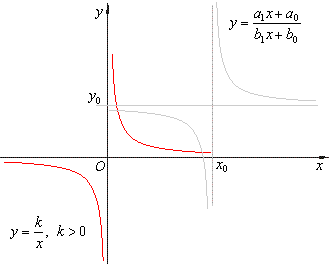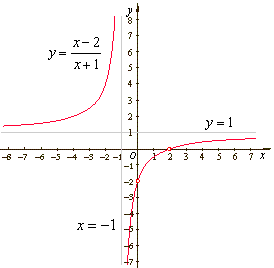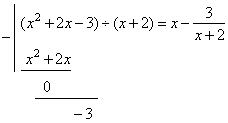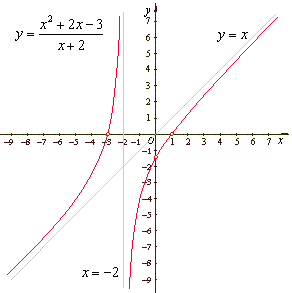|
|
|
Rational
Functions |
 Basic
properties of rational functions
Basic
properties of rational functions |
|
Vertical asymptotes of
rational functions |
|
Horizontal asymptotes
of rational functions |
|
The oblique or slant
asymptote of rational functions |
 The
graph of the reciprocal function
f
(x) = c/x, equilateral or rectangular hyperbola
The
graph of the reciprocal function
f
(x) = c/x, equilateral or rectangular hyperbola |
 Translation of
the reciprocal function
f
(x) = (ax + b)/(cx + d), linear rational function
Translation of
the reciprocal function
f
(x) = (ax + b)/(cx + d), linear rational function |
|
Graphing rational
functions examples |
|
|
|
|
|
|
| Basic
properties of rational functions |
| The
functions that most likely have asymptotes are rational
functions. |
|
| Vertical
asymptote |
| The
line x =
a is a vertical asymptote
of a function
f
if f
(x)
approaches infinity (or negative infinity)
as x
approaches
a
from the left or right. |
| So,
vertical asymptotes occur when the denominator of the simplified
rational function is equal to 0. Note that the simplified
rational function has cancelled all factors common to both the
numerator and denominator. |
|
| Horizontal
asymptote |
| The
line y =
c is a horizontal
asymptote of a function
f
if
f (x)
approaches c
as
x
approaches
infinity (or negative infinity). |
| The
existence of the horizontal asymptote is related to the degrees
of both polynomials in the numerator and the denominator of
the given rational
function. |
| Horizontal
asymptotes occur when either, the degree of the numerator is
less then or equal to the degree of the denominator. |
In
the case when the
degree (n) of the numerator is less then the degree
(m) of the
denominator,
the x-axis
y =
0
is the asymptote. |
| If
the degrees of both polynomials, in the numerator and the denominator, are equal then,
y = an
/ bm
is the horizontal asymptote,
written as the ratio of their highest degree term coefficients respectively. |
| When
the degree of the numerator of a rational function is greater
than the degree of the denominator, the function has no
horizontal asymptote. |
|
| Oblique or slant
asymptote |
| The
line y =
mx
+ c is a
slant or oblique asymptote of
a function
f
if f
(x)
approaches
the line
as
x approaches infinity
(or negative infinity). |
| A
rational function will
have a slant (oblique) asymptote
if the
degree (n)
of the numerator is exactly one more than the degree (m)
of
the denominator that is if n
= m + 1. |
| Dividing
the two polynomials
that form a rational function,
of which the
degree
of the numerator
pn (x)
is exactly one more than the degree
of
the denominator qm
(x), then |
| pn
(x)
= Q (x) · qm (x) + R
=>
pn (x) / qm (x)
= Q (x) + R / qm (x) |
| where,
Q (x)
=
ax + b
is the quotient and R
/ qm (x)
is the remainder with constant R. |
| The
quotient Q
(x)
=
ax + b
represents the equation of the slant asymptote. |
| As
x
approaches
infinity (or negative infinity),
the remainder R/qm(x)
vanishes (tends to zero). |
| Thus,
to find the equation of the slant asymptote, perform the long
division and discard the remainder. |
| The
graph of a rational function will never cross its vertical
asymptote, but may cross its
horizontal or slant asymptote. |
|
| The
graph of the reciprocal
function or equilateral or rectangular hyperbola |
| The
graph of the reciprocal function y
= 1/x or y
= k/x is a
rectangular (or right) hyperbola of which asymptotes are the
coordinate axes. |
| If
k
> 0 then,
the function is decreasing from zero to negative
infinity and from positive infinity to zero,
i.e., the graph of the rectangular hyperbola has
two branches, in the first and third quadrants as is
shown in the right figure. |
| The
hyperbola has two axes of symmetry. |
| The
vertices, |
 |
|
|
|
 |
|
|
| Translation
of the reciprocal function or linear rational function |
| The
rational function |
 |
by
dividing the numerator by denominator, |
|
| can
be rewritten into |
 |
where, |
 |
|
| is
the constant, |
 |
are
the vertical and the horizontal asymptote respectively. |
|
| Therefore,
the values of the vertical and the horizontal asymptotes
correspond to the coordinates of the horizontal and the vertical
translation of the reciprocal function y
= k/x as is
shown in the figure below. |
 |
|
| Graphing rational
functions examples |
| Example: Given
the rational function |
 |
sketch
its graph. |
|
| Solution:
The
vertical asymptote can be found by finding the root of the
denominator, |
|
x + 1 = 0 =>
x = -1
is the vertical asymptote.
|
|
The
horizontal asymptote is the ratio of their
highest degree term coefficients since
the degree of polynomials in the numerator and denominator are equal,
|
| |
 |
is the
horizontal asymptote. |
|
|
The graph of the given rational function is translated equilateral (or rectangular)
hyperbola shown below.
|
| The
rational function of the
form
|
 |
can
be rewritten into
|
|
 |
|
|
| where, x0
and y0
are asymptotes and k
is constant. |
|
 |
|
|
Therefore, values of the vertical and
the horizontal asymptote correspond to the coordinates of the horizontal and the vertical translation
of the source equilateral hyperbola y
= k/x, respectively.
|
|
|
| Example: Given
the rational function |
 |
sketch
its graph. |
|
| Solution:
The
vertical asymptote can be found by finding the root of the
denominator, |
|
x + 2 = 0 =>
x = -2
is the vertical asymptote.
|
| Since
the
degree
of the numerator is exactly one more than the degree of
the denominator the given rational function has the slant
asymptote. |
| By dividing the
numerator by the denominator |
 |
| obtained is
the slant asymptote y
= x and
the remainder
3/(x + 2) that vanishes as x
approaches
positive or negative infinity. |
|
 |
|
|
|
|
|
|
|
|
|
|
|
|
| Functions
contents C |
|
 |
|
| Copyright
© 2004 - 2020, Nabla Ltd. All rights reserved. |